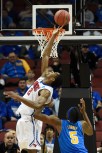
(USA TODAY Sports Images)
In the immediate aftermath of the crazy UCLA-SMU finish, no one knew what to think about the goaltending call that put UCLA in the lead, for good, with 10.7 seconds remaining. Yanick Moreira, the player who was called for goaltending, essentially admitted that he committed the violation, cried and blamed himself for the loss. The television announcers and analysts were as clueless as the audience. On CBS, John Adams, the NCAA national coordinator of men’s basketball officiating, spoke in circles and did absolutely nothing to clarify the situation.
On FTW, I initially wrote that I thought the refs got the call right, or that theoretically going to replay (if it was allowed) would have been inconclusive. But as the hours passed and CBS, TNT, TBS and TruTV kept showing the replays more and more, the answer became clearer and clear.
This wasn’t goaltending.
This wasn’t close to goaltending. UCLA shouldn’t have been awarded three points, and SMU should have had the ball with a two-point lead and 10.7 seconds left. A few free throws and the Mustangs would have had their first NCAA win since 1988.
It should have been that way. The major fallacy held by most people is that interfering with a ball that will hit the rim is automatically goaltending. But that’s not true. Here is the definition of goaltending, as written in the official 2014 & 2015 NCAA Men’s Basketball Rules.
“Violations- Goaltending. (Rule 9-17.5). When the ball contacts the backboard and any part of the ball is above the rim on a field goal attempt, it is considered to be on its downward flight. In such case, it is goaltending when the ball is touched by a player as long as it has a possibility of entering the basket.”

Those last 11 words are key: “as long as it has a possibility of entering the basket.” By that phrasing, a ball that is clearly short, long or wide, but might hit the rim anyway, is not eligible for goaltending. Just, for example, think of a baseline three that’s woefully short. The top half of the ball would thud against the rim and either fall straight down or bounce back toward the shooter. In that case, if an opposing player grabbed the ball on the way down, but before it grazed the rim, that would not be a goaltend, by rule.
Let’s apply that to the shot from UCLA-SMU. Clearly this ball is long. It looks like it will make contact with the rim but, at best, it would graze it and slide off. But there is no chance of this ball going in. None at all. Even the craziest carom couldn’t get that ball through that hoop. It’s going long no matter what.
The refs didn’t see it that way. Ordinarily, you couldn’t rip them for that. This play was almost impossible to call in realtime and it’s a crime that the NCAA seems to allow video review for almost everything else except goaltending. But then, after a few dozen views, you’ll notice the ref who made the call.

It would have been hard for any of the three officials to blow the whistle, but especially for the one farthest from the basket. The official on the baseline made no such ruling and he was standing right under the basket. The ref on the near sideline is only signaling that it’s a three-pointer. So a 50/50 call in realtime that ended up not being goaltending was only made because a ref 28 feet away decided that he could tell a ball on its way down “had the possibility of entering the basket.”
But, again, the real problem isn’t with the call, it’s with the inability to review it. With no recourse for the wrong call, the most storied college basketball program of all time stole a win from a school that was playing in only its second tournament in a quarter-century.
You got jobbed, SMU. Be angry. Be very, very angry.

(USA TODAY Sports Images)







